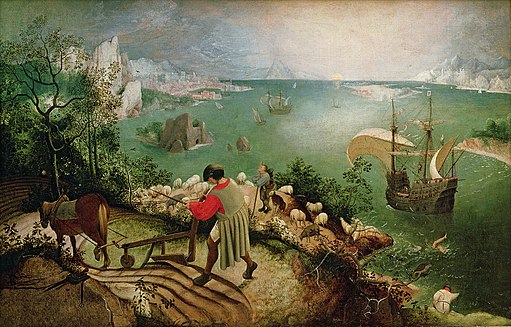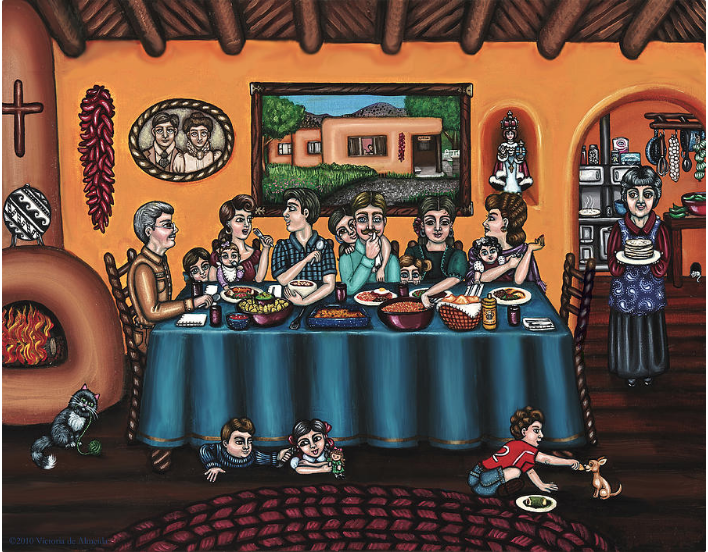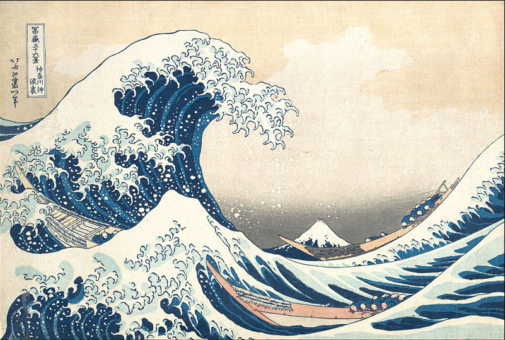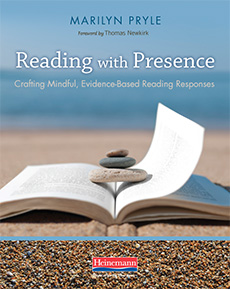School Leadership 2.0
A Network Connecting School Leaders From Around The Globe
3 Ways to Help Students Analyze Visual Texts
3 Ways to Help Students Analyze Visual Texts
BY MIDDLEWEB · 11/13/2018

By Marilyn Pryle
Students love visual texts such as art and photographs, but as with written texts, they often don’t know where to begin when asked to look at the works critically.
Some may even feel intimidated if prompted to respond to a form of visual art. When shown a painting, they may say, “It’s good,” or “I like it.” When asked why, they may vaguely note the subject of the painting or talk about how the painting makes them feel.
These are excellent beginnings, but rarely do students go much further on their own.
I’ve learned that if students are given specific doorways that make visual texts more accessible, and a structured space to formulate some detailed thoughts, they will have much richer discussions. In my English class, I use a system of Reading Responses (a topic I wrote about in September here at MiddleWeb) to help students enter into written texts. I soon realized that this system can work with visual texts too.
Writing Reading Responses is a daily or almost-daily practice of having students craft brief, structured responses to whatever text they have read. There are four rules to writing a Reading Response:
- Choose a category of response, using the list of possible categories, and write the category name at the top of the response.
- Develop an original thought within that category and write out the thought.
- Find, copy, and cite a line, paragraph, or page from the text that relates to the original thought. (When responding to visual texts, specific details from the piece will suffice.)
- Keep writing and thinking for at least five sentences.
My students have over 30 categories to choose from when responding to written text. These range from “Spot the Setting” and “Mark the Motivation” to “Feminist Criticism” and “Archetype Alert” (see my earlier article for some examples).
When responding to art, students may be able to apply some of these literary categories to the piece. One can certainly talk about art in terms of mood, theme, and symbols, just as one would with written texts. But as we analyzed more and more art in my class, I decided to generate a few special response categories that only pertain to visual texts.
Here are three of those categories – Find the Focus, Consider the Colors, and Point Out the Perspective – specifically created for analyzing art, photography, or some other visual text.
Category: Find the Focus
Directions to Students: What is the focal point of this work? How do you know? What is the artist trying to communicate by making this point the focus? How does it relate to the rest of the piece?
In most paintings and photographs, the focus is easily seen. The artist wants us to be drawn to the focal point; our natural instincts should direct us to where it is. Still, students will sometimes look at a painting or picture and say they don’t know what’s happening in it at all.
This category asks students to trust their intuition, and then find evidence for it. That evidence can consist of lighting or color or positioning—whatever they find, I want students to identify some detail that supports their thinking, exactly as they must do for written texts. They are practicing the same skill.
 https://www.middleweb.com/wp-content/uploads/2018/11/512px-Pieter_B... 300w" sizes="(max-width: 511px) 100vw, 511px" />
https://www.middleweb.com/wp-content/uploads/2018/11/512px-Pieter_B... 300w" sizes="(max-width: 511px) 100vw, 511px" />Pieter Brueghel the Elder [Public domain]
Find the Focus for Landscape with the Fall of Icarus (P. Brueghel)
Student Response by Clay: The focus of the artwork is near the center where the man is tilling his field. I think this because it is near the center and his colors are the most bright even though he isn’t the most important in the image. Icarus falling into the water is in the background, which was actually hard to find at first. I think that the artist did this in order to show that no one was paying attention and their lives continued normally. Daedalus isn’t even in the picture and Icarus is hard to see since only half of him is visible. This part of the piece is like the rest of the artwork, everyone is minding their own business as their lives continue while Icarus is drowning to death.
Category: Consider the Colors
Directions to Students: What do the colors in this piece communicate? You can examine a specific color choice or the whole palette. What mood do the colors create? How do the colors relate to the theme / message of the piece?
In a piece of art or a photograph, perhaps the first element the viewer registers, even before the focus, is color. Colors set the mood of the piece in our minds, consciously or subconsciously. This applies to infographics (even comics) as well. I want students to realize how their perceptions of the work are shaped by their reactions to the colors within it.
Just as a writer crafts mood with descriptions of setting, artists craft mood with color. Students should use the “textual evidence” of color to make inferences about the work’s message.
 https://www.middleweb.com/wp-content/uploads/2018/11/mp-the-family-... 300w, https://www.middleweb.com/wp-content/uploads/2018/11/mp-the-family-... 436w" sizes="(max-width: 500px) 100vw, 500px" />
https://www.middleweb.com/wp-content/uploads/2018/11/mp-the-family-... 300w, https://www.middleweb.com/wp-content/uploads/2018/11/mp-the-family-... 436w" sizes="(max-width: 500px) 100vw, 500px" />
Consider the Colors for La Familia (Victoria De Almeida)
Student response by Alie: The overall atmosphere of this painting is warm and friendly. The bright orange walls bring a feeling of warmth and happiness. The tablecloth is a rich blue, contrasting the orange and indicating that the table is the focus of the painting. Most of the people in the picture are also wearing darker colors, mostly on the cool side of the color spectrum. Through this the artist is making the people stand out. The woman on the right with a dish in her hands also seems to be important because she is the only person in the painting who is standing.
Category: Point Out the Perspective
Directions to Students: What is the perspective of this piece, and how is it important? How does the artist create the perspective? How does it relate to the mood of the piece? How does it relate to the theme?
This category parallels the idea of point of view for written texts. It asks students to consider the angle the “story” is viewed from. Of course, perspective can change everything, in literature and in life. I want students to realize that how they view a scene in art is not an absolute; rather, it was a deliberate choice of the artist.
The artist controls our perception in order to shape our understanding of subject and theme. If students can recognize this in visual texts, they will better recognize it in written texts as well.
 https://www.middleweb.com/wp-content/uploads/2018/11/mp-tsunami-300... 300w, https://www.middleweb.com/wp-content/uploads/2018/11/mp-tsunami-768... 768w, https://www.middleweb.com/wp-content/uploads/2018/11/mp-tsunami.png 801w" sizes="(max-width: 505px) 100vw, 505px" />
https://www.middleweb.com/wp-content/uploads/2018/11/mp-tsunami-300... 300w, https://www.middleweb.com/wp-content/uploads/2018/11/mp-tsunami-768... 768w, https://www.middleweb.com/wp-content/uploads/2018/11/mp-tsunami.png 801w" sizes="(max-width: 505px) 100vw, 505px" />Katsushika Hokusai [Public domain]
Point out the Perspective for The Great Wave off Kanagawa(K. Hokusai)
Student response by Brett: The painting, The Great Wave Off Kanagawa, has a unique way of showing just how important perspective is. The wave is much larger than the boat in the background, which just shows how close the wave is to the boats. The picture shows the potential for a huge disaster caused by the gigantic waves. The other waves seem to be heavy as well, due to the angle in which we see the water is approaching the boats. The ocean is definitely the focal point of the piece, as there are very tiny mountains in the back, showing that these mountains could perhaps be miles and miles away, being very anti-climactic and tiny.
Writing Reading Responses about visual texts will build students’ confidence in approaching art with a critical eye. Students quickly realize that they don’t have to read the mind of the artist or reveal the meaning of life as related in the work.
Rather, they only need to have one specific, concrete thought that they can support with details that they see. It feels manageable and safe. In class, these individual thoughts then become a rich, meaningful, student-led discussion full of detail and discovery.
This article is adapted from the book Reading with Presence, Heinemann, 2018.
____________________________________________
 Marilyn Pryle (@MPryle) is a National Board Certified Teacher in Clarks Summit, PA, and has taught middle and high school English for over twenty years. She is the author of several books about teaching reading and writing, including 50 Common Core Reading Response Activities, Writing Workshop in Middle School and 2018’s Reading with Presence. Learn more about Marilyn at marilynpryle.com and read other articles she’s written for MiddleWeb here.
Marilyn Pryle (@MPryle) is a National Board Certified Teacher in Clarks Summit, PA, and has taught middle and high school English for over twenty years. She is the author of several books about teaching reading and writing, including 50 Common Core Reading Response Activities, Writing Workshop in Middle School and 2018’s Reading with Presence. Learn more about Marilyn at marilynpryle.com and read other articles she’s written for MiddleWeb here.
JOIN SL 2.0
SUBSCRIBE TO
SCHOOL LEADERSHIP 2.0
Feedspot named School Leadership 2.0 one of the "Top 25 Educational Leadership Blogs"
"School Leadership 2.0 is the premier virtual learning community for school leaders from around the globe."
---------------------------
Our community is a subscription-based paid service ($19.95/year or only $1.99 per month for a trial membership) that will provide school leaders with outstanding resources. Learn more about membership to this service by clicking one of our links below.
Click HERE to subscribe as an individual.
Click HERE to learn about group membership (i.e., association, leadership teams)
__________________
CREATE AN EMPLOYER PROFILE AND GET JOB ALERTS AT
SCHOOLLEADERSHIPJOBS.COM
New Partnership
Mentors.net - a Professional Development Resource
Mentors.net was founded in 1995 as a professional development resource for school administrators leading new teacher induction programs. It soon evolved into a destination where both new and student teachers could reflect on their teaching experiences. Now, nearly thirty years later, Mentors.net has taken on a new direction—serving as a platform for beginning teachers, preservice educators, and
other professionals to share their insights and experiences from the early years of teaching, with a focus on integrating artificial intelligence. We invite you to contribute by sharing your experiences in the form of a journal article, story, reflection, or timely tips, especially on how you incorporate AI into your teaching
practice. Submissions may range from a 500-word personal reflection to a 2,000-word article with formal citations.
You need to be a member of School Leadership 2.0 to add comments!
Join School Leadership 2.0